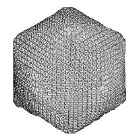Plant Pathology, Department of

James Van Etten Publications
Document Type
Article
Date of this Version
1-2016
Citation
Published in final edited form as: Angew Chem Int Ed Engl. 2016 January 11; 55(2): 654–658.
doi:10.1002/anie.201509150.
Author manuscript; available in PMC 2017 January 11.
Abstract
N-glycosylation is a fundamental modification of proteins that exists in the three domains of life and in some viruses, including the chloroviruses, for which a new type of core N-glycan is described. This N-glycan core structure common to all chloroviruses is a pentasaccharide with a β-glucose linked to an asparagine residue that is not located in the typical sequon N-X-T/S. The glucose is linked to a terminal xylose unit and a hyperbranched fucose, in turn substituted with a terminal galactose and a second xylose residue. The third position of the fucose unit is always linked to a rhamnose, which is a semi-conserved element because its absolute configuration is virus-dependent. Additional decorations occur on this core N-glycan and represent a molecular signature for each chlorovirus.
Includes supplemental materials.


Comments
Copyright 2016 Wiley-VCH Verlag GmbH & Co. KGaA, Weinheim. Used by permission.